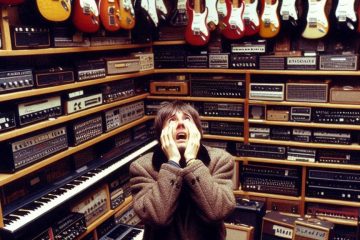The de-esser is a wonderful tool. We’re actually pretty spoiled by having them when you consider the process involved with de-essing before they were invented.
Engineers would use a number of techniques to help reduce sibilance in a vocal take. George Martin and Andrew Scheps try to avoid sibilance in the recording by using different mics or coaching the vocalist to give a performance that helps minimise sibilance. Others utilised fairly involved set ups with multing out vocals, sidechaining compressors etc. to help reduce sibilance in the mix.
Having de-essers still doesn’t invalidate the above techniques. Getting a great performance out of a vocalist with the right sort of mic is still a 101 task for the engineer. The less post processing the better.
How Should We Use De-essers?
When I was a younger engineer I used to pop a de-esser on a vocal, find the specific frequency of the esses for that vocal and de-ess until it sounded like a lisp and then backed it off until it sounded natural.
That’s actually not a terrible approach BUT there are some tweaks that I’ve adopted that help that vocal to sound that much more natural and transparent when being de-essed.
How Much Reduction?
Personally, I try to aim for 9dB now. Why don’t I do the lisp thing? Like in mastering, where the rule of thumb for equalising is plus or minus 3dB, when you’re excessively de-essing you’re tampering with subtle harmonic content in the top of the vocal more than you should.
The caveat to this is a poorly recorded vocal where you just need to get that sibilance under control. BUT is there a better way?
Manual De-essing
Rudy Van Gelder, George Martin, Tom Dowd and Bruce Swedien all have something in common. You guessed it, they manually de-essed vocals.
Whilst in the days of tape, this was a much more precarious technique (as was splicing tapes). Nowadays we have it easy but that makes it easy to be lazy too.
What does manual de-essing look like in 2023? Automation of the audio prior to processing via a de-esser. My approach is pretty simple:
- Add the de-esser and get it reducing around 9dB in the sibilant area of the vocal.
- Solo the vocal and listen for nasty artefacts that the de-esser might be creating when reducing the gain of those frequencies.
- Zoom into the wave form and find the offending section of audio and draw in a quick volume fade.
- Tune the amount by ear so it sounds good in solo but then check in context with the whole mix.
- This technique can be applied to de-breathing as well even if you’re using a de-breather.
Also Good For Your Ps and Bs
I also find this technique works well for plosives. You can use EQ to help catch the bulk of the low end of the sound but there’s a line where the voice get’s thinned out. I’ll find that point and then I’ll shave off the start of the plosive. Basically you’re redrawing the attack of the plosive sound.
Why Not Just Use Clip Gain?
You certainly could use clip gain, I find this method works for me and has more flexibility if you need to get creative with the volume rides.
Could You Use Multiband Compression?
Definitely. Understanding which tools and when to use them is essential to becoming a seasoned mix engineer.
Controlling General Vocal Dynamics
I haven’t touched on this technique for controlling the general dynamics of the vocal. This technique can be applied in general to your vocals prior to processing so it doesn’t hit your compression too hard or soft.
The Takeaway: Realistically, it takes 10 – 20 minutes to treat a vocal like this and why wouldn’t you? It’s the star of the show. That little bit of extra love for the vocal goes a long way and will noticeably improve the level of your productions. Get busy with those automation nodes.



0 Comments